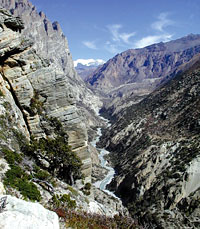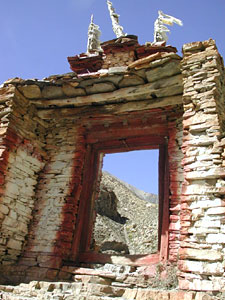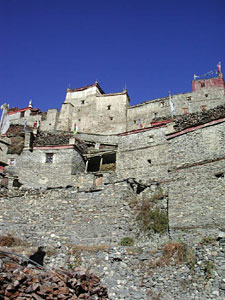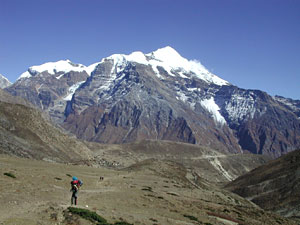 'When you come around the corner, you will see a sight that will move your soul.' So wrote my Sirdar in an email to me after his reconnaissance trip into the Nar Phu valleys in August 2005.
'When you come around the corner, you will see a sight that will move your soul.' So wrote my Sirdar in an email to me after his reconnaissance trip into the Nar Phu valleys in August 2005.
Two months later, I laid eyes on the village of Phu. Like a medieval castle it rises almost 40m above a dusty riverbed. Steep walls eroded by relentless wind and weather protect the 30-40 basic stone houses sheltered behind, built atop one another like a vertical jigsaw puzzle. It had taken us over a week to walk to Phu, following the Annapurna Circuit as far as Koto and then heading north through a narrow gorge, alongside a thundering river and into the high, arid valleys that Bhotia people have inhabited for many centuries.
No sooner had we set up camp across the river from Phu than we were visited by a gaggle of cheeky, dusty children already a little trekker-savvy and bold enough to peer into our tents. In the early 1980s, sociologist Christoph von Furer Haimendorf and a team of researchers visited the Nar Phu valleys when they were still off-limits to trekkers. In an academic paper in the journal Kailash, he wrote: 'The decision of the Government of Nepal to not expose such regions to the increasing flood of tourists had had the great advantage of shielding at least a small percentage of mountain dwellers from the commercialism of a tourist trade which has already transformed the social and cultural pattern of such communities as the Sherpas of Khumbu.'
But in 2003, Nar Phu was opened for trekking. Climbing expeditions have been visiting the region since the 1950s to attempt the nearly 7,000-m Mt Kanguru, whose imposing western flanks dominate the approaches to the two valleys. In 2004, 244 permits were issued to visit Nar Phu. In October 2005, when my group visited, it appeared this number might easily be surpassed. Operators of adventure travel companies have promoted the area as an exciting new destination and, like myself, are thrilled that it offers an affordable alternative to the expensive Mustang region and the increasingly congested Annapurna Circuit.
The relatively cheap permit fee, accessibility and its pristine locale have made the Nar Phu valleys an attractive option.

Mani stones at the monastory looking down towards fortress-like Phu.

Children of Phu.

Looking northward along the gorge leading to Phu.
While the inhabitants of Nar and Phu have maintained regular trading relations with Manang and Chame for centuries, they have undoubtedly already been affected in a different way by trekkers visiting the region. Some spoke positively to us about the benefits of more visitors to Phu. Several women have kitchen, lodge and guide training through ACAP. Solar panels have sprouted on many roofs in Phu, delivering power and creating a twinkling light show for campers below. We met people in both villages with relatives in Kathmandu, who choose to escape the harsh winters by migrating to the city instead of to the winter settlements of Meta and Kyang lower in the valley. In Nar, a New Zealand supported micro-hydro station delivers power and rooftops are criss-crossed with power lines.
For trekkers, the valleys are special places, offering glimpses into the past and a chance to reflect on how harsh life can be. In debating the effects of our presence, we all agreed that careful management will be key to retaining what is special and unique about the valleys.
Most people in the world want progress. The people of Nar Phu are no different. As a country that relies heavily on tourism, the key for Nepal will be finding a balance that will protect what is special about Nar Phu yet still allow its inhabitants a chance to make their lives a little easier.
Wanda Vivequin is a Canada-based trekking guide who visited the Nar Phu valleys in October 2005
Avalanche!
 The Nar Phu valleys made headlines on 20 October for all the wrong reasons. Eighteen people, seven French climbers and 11 Nepali guides and porters, were buried in an avalanche on Mt Kanguru, propelling this isolated region into the news. (See: 'Do not take the mountains lightly', #270). A French rescue team with sniffer dogs is on the mountains trying to dig through the ice and debris deposited at the bottom of the gully where the avalanche swept the camp.
The Nar Phu valleys made headlines on 20 October for all the wrong reasons. Eighteen people, seven French climbers and 11 Nepali guides and porters, were buried in an avalanche on Mt Kanguru, propelling this isolated region into the news. (See: 'Do not take the mountains lightly', #270). A French rescue team with sniffer dogs is on the mountains trying to dig through the ice and debris deposited at the bottom of the gully where the avalanche swept the camp.
Just one day after we crossed the 5,300m Kang La Pass that connects Nar with Manang Valley, the region was pummelled by unseasonal blizzards that relentlessly dumped over 1.5m of snow in 72 hours (pic, above). A British climber spent eight days trapped in Phu, followed by a treacherous trek that involved fixing ropes to move along the precipitous trails, wading through chest-deep snow and listening to avalanches peeling off the mountains all around.
Members of a French expedition on nearby Himlung were lucky to be in their base camp when the storm hit, eventually spending 17 hours trekking to Phu, a walk that normally takes four hours. They were finally helicoptered out of the valley.
Three hundred yaks from Nar were killed in the storm, dealing a devastating blow to a people who rely on these animals for subsistence. Just a week earlier, we had watched the people of Nar Phu busily preparing for winter, families working together in the fields and on their flat rooftops as they have done for centuries. The people of Phu now seem resigned to the fact that this will be a harsh winter. The harvesting was far from complete and autumn grazing has been all but wiped out.
WEB EXCLUSIVE | PHOTO GALLERY
ALL PICS WANDA VIVEQUIN










